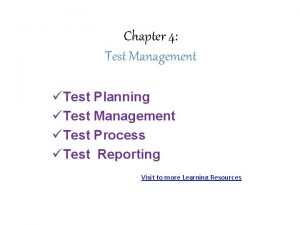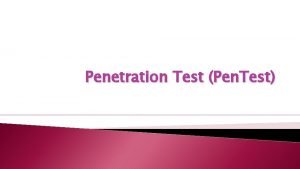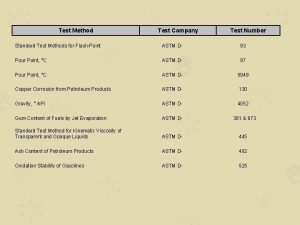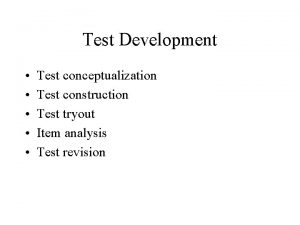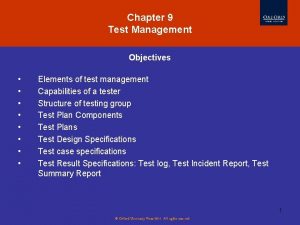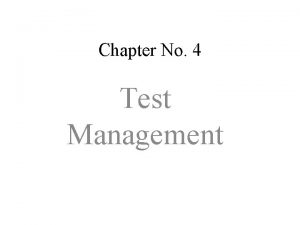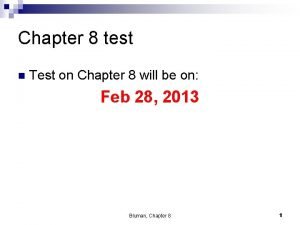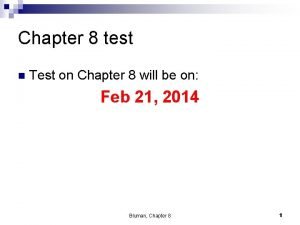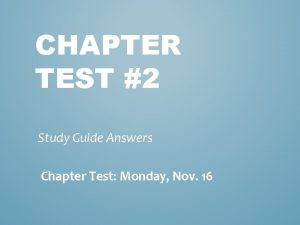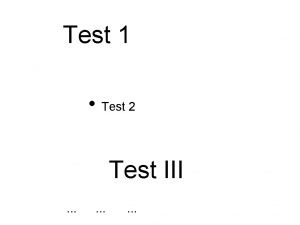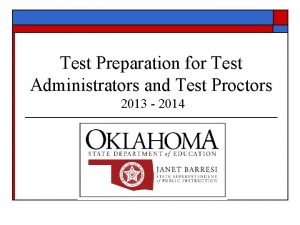Chapter 5 Test Management Test management Test management





















- Slides: 21

Chapter 5 Test Management

Test management • Test management most commonly refers to the activity of managing a testing process. A test management tool is software used to manage tests (automated or manual) that have been previously specified by a test procedure. It is often associated with automation software. Test management tools often include requirement and/or specification management modules that allow automatic generation of the requirement test matrix (RTM), which is one of the main metrics to indicate functional coverage of a system under test (SUT).

What is Test Management? Ø An important part of software quality is the process of testing and validating the software. v Test Management is the practice of • Organizing and controlling the Testing process. • Ensuring visibility, traceability, and control of testing process to deliver high-quality software.

Test Lead/Leadership Skills And Responsibilities • By definition, the basic responsibility of any Test Lead is to effectively lead a team of testers to meet the product goals and thereby achieving the organizational goals that are derived

A Test Lead is most commonly responsible for the following activities:

#1) He must be able to identify how his test teams align within an organization and how his team would achieve the roadmap identified for the project and the organization. #2) He needs to identify the scope of the testing required for a particular release based on the requirements of the document. #3) Put out the Test Plan after discussions with the test team and have it reviewed and approved by the Management/ Development team. #4) Must identify the required metrics and work to have them in place. These metrics could be an inherent goal for the test team. #5) Must identify the testing effort required by calculating the sizing needed for the given release and plan the required effort for the same. #6) Figure out what skills are required and balance the test resources accordingly with those needs based on their own interests as well. And also identify if there any skill gaps and plan for training & education sessions for the identified test resources.

#7) Identify the tools for Test Reporting, Test Management, Test Automation, etc. and educate the team on how to use those tools. Again, plan knowledge transfer sessions if required to the team members for the tools that they would use. #8) Retaining skilled resources by instilling leadership in them and offer guidance to the junior resources as and when required thereby enabling them to grow. #9) Create fun and conducive environment for all the resources to make sure they have maximum throughput.

Responsibilities of a Test Manager / Lead • Understand the testing effort by analyzing the requirements of project. • Estimate and obtain management support for the time, resources and budget required to perform the testing. • Organize the testing kick-off meeting • Define the Strategy • Build a testing team of professionals with appropriate skills, attitudes and motivation. • Identify Training requirements and forward it to the Project Manager (Technical and Soft skills). • Develop the test plan for the tasks, dependencies and participants required to mitigate the risks to system quality and obtain stakeholder support for this plan. Arrange the Hardware and software requirement for the Test Setup. •

• Document, implement, monitor, and enforce all processes for testing as per standards defined by the organization. • Check / Review the Test Cases documents. • Keep track of the new requirements / change in requirements of the Project. • Escalate the issues about project requirements (Software, Hardware, Resources) to Project Manager / Sr. Test Manager. • Organize the status meetings and send the Status Report (Daily, Weekly etc. ) to the Client • Attend the regular client call and discuss the weekly status with the client.

• Communication with the Client (If required). • Act as the single point of contact between Development and Testers. • Track and prepare the report of testing activities like testing results, test case coverage, required resources, defects discovered and their status, performance baselines etc. • Review various reports prepared by Test engineers. • Ensure the timely delivery of different testing milestones. • Prepares / updates the metrics dashboard at the end of a phase or at the completion of project. • Assign task to all Testing Team members and ensure that all of them have sufficient work in the project. Ensure content and structure of all Testing documents / artifacts is documented and maintained. • •

The roles of Test leader and Test manager in software testing process of IT projects are • Building and leading the testing team to the success of the project. • Develop test strategy and test plans for projects • Participate in developing and reviewing the test policies for organisation. • Defining the scope of testing within the context of every release and every software testing level or cycle. • The use of resources in an effective way and managing the resources for software testing. • Applying the appropriate test measurement and metrics for the software product and testing team.

Ø Identify and resolve the project risks in testing team like. No enough time to test • Not enough resources to test • The project budget is low • Testing teams are offshore • The requirements are too complex

• The test leader or test manager plays an important role at an outset of the project. • They will in work collaboration with the stake holders, devise the test objectives, organisational test objectives, policies, test strategies and test plans. • They decide when test automation is appropriate and they put effort and plan to select the tools and ensure training the testing team. • During test implementation the test managers / test leaders make sure that the test environment is set up and verified before test execution and managed during the test execution.

IEEE 829 test plan structure • • • • • IEEE 829 -2008, also known as the 829 Standard for Software Test Documentation, is an IEEE standard that specifies the form of a set of documents for use in defined stages of software testing, each stage potentially producing its own separate type of document. [1] These stages are: Test plan identifier Introduction Test items Features to be tested Features not to be tested Approach Item pass/fail criteria Suspension criteria and resumption requirements Test deliverables Testing tasks Environmental needs Responsibilities Staffing and training needs Schedule Risks and contingencies Approvals

What is Test Monitoring? The test monitoring framework must consist of exhaustive steps and specific targets required to correlate the current status of test work products and tasks to the planned and strategic objectives. • Comparing the current status of test work products and tasks, against the plan and strategic objectives is simpler for projects that are small or less complex. • However, for other projects a more detailed objective must be defined to accomplish this. • Targets and measures that are needed to achieve the objectives of the test and test basis coverage can be included in this. • This can be achieved by clearly outlining the test goals and assessing progress against predefined set of test conditions by mapping work products related to testing with test basis through test conditions.

What is Test Control? • Test control must be a continuous exercise. It includes comparison of actual test progress versus planned progress and taking remedial actions if required. • In simple terms, test control refers to controlling the testing process in order to meet the goal of the project like achieving a target percentage for test coverage or completing testing on a specific date etc.

• It manages the testing process to accomplish defined objectives, strategies and overall goal. • In the process, you may need to revisit the test planning activities and modify them suitably. • Some of the possible actions that can be taken to control the testing process and bring it back on track could be – addition of extra resources, reducing the scope of the release, splitting the release into multiple releases etc. • The action that needs to be taken to control the test process will depend on a number of factors like stakeholders, development lifecycle, budget, project complexity etc.




 Similarity ratio definition
Similarity ratio definition Chapter 4 section 1 population dynamics study guide
Chapter 4 section 1 population dynamics study guide Operations management chapter 12 inventory management
Operations management chapter 12 inventory management Top management middle management first line management
Top management middle management first line management Management pyramid
Management pyramid Top management and middle management
Top management and middle management Red tent summary
Red tent summary Summary of chapter 8 gatsby
Summary of chapter 8 gatsby Chapter 10 chemical reactions answer key
Chapter 10 chemical reactions answer key Chapter 11 study guide chemistry stoichiometry answer key
Chapter 11 study guide chemistry stoichiometry answer key Chapter 9 chapter assessment chemical reactions
Chapter 9 chapter assessment chemical reactions Chapter 6: career readiness
Chapter 6: career readiness Chapter 7 ionic and metallic bonding chapter answer key
Chapter 7 ionic and metallic bonding chapter answer key Chapter 9 surface water answer key
Chapter 9 surface water answer key Representing motion physics answers
Representing motion physics answers Chemistry: the central science chapter 14 answers
Chemistry: the central science chapter 14 answers Chapter 7 ionic and metallic bonding assessment answer key
Chapter 7 ionic and metallic bonding assessment answer key Chapter 2 standardized test practice answers
Chapter 2 standardized test practice answers Book of philippians background
Book of philippians background Ionic compounds
Ionic compounds 7 ionic and metallic bonding practice problems
7 ionic and metallic bonding practice problems Dichlorine octoxide formula
Dichlorine octoxide formula






















